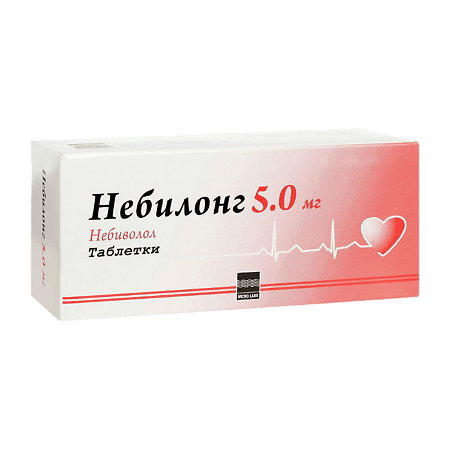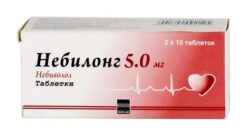No products in the cart.
Nebilong, tablets 5 mg 50 pcs
€29.16 €24.30
Description
NEBILONG is a highly selective competitive -adrenoreceptor blocker. Due to metabolic interaction with L-arginine/nitric oxide it shows moderate vasodilator effect. In therapeutic doses it does not exhibit membrane stabilizing and draining activity. It decreases HR and BP at rest and during exercise both in patients with normal BP and in those with arterial hypertension.
Indications
Indications
Arterial hypertension.
Prevention of attacks of stable angina in coronary heart disease
Chronic heart failure (as part of combination therapy).
Pharmacological effect
Pharmacological effect
NEBILONG is a highly selective competitive blocker of β-adrenergic receptors. Due to metabolic interaction with L-arginine/nitric oxide, it exhibits a moderate vasodilator effect. In therapeutic doses it does not exhibit membrane stabilizing or drainage blocking activity. Reduces heart rate and blood pressure at rest, as well as during exercise in both patients with normal blood pressure and arterial hypertension.
Special instructions
Special instructions
The withdrawal of beta-blockers should be carried out gradually over 10 days (up to 2 weeks in patients with coronary heart disease.
Monitoring blood pressure and heart rate at the beginning of taking the drug should be daily.
In elderly patients, monitoring of kidney function is necessary (once every 4-5 months).
For exertional angina, the selected dose of the drug should ensure the heart rate at rest within the range of 55-60 beats/min, with a load of no more than 110 beats/min.
When deciding whether to use the drug Nebilong, patients with psoriasis should carefully weigh the expected benefits of using the drug and the possible risk of exacerbation of psoriasis.
When performing surgical interventions, the surgeon/anesthesiologist should be warned that the patient is taking Nebilong.
Nebivolol does not affect plasma glucose concentrations in patients with diabetes mellitus. However, caution should be exercised when treating these patients because Nebilong may mask certain symptoms of hypoglycemia (eg, tachycardia) caused by the use of hypoglycemic agents.
Monitoring the concentration of glucose in the blood plasma should be carried out once every 4-5 months. (in patients with diabetes mellitus).
Beta blockers should be used with caution in patients with COPD as bronchospasm may be increased.
In case of hyperfunction of the thyroid gland, the drug neutralizes tachycardia.
Beta blockers may increase sensitivity to allergens and the severity of anaphylactic reactions.
The effectiveness of beta-blockers in smokers is lower than in non-smoking patients.
Impact on the ability to drive vehicles and operate machinery:
During the treatment period, care must be taken when driving vehicles and engaging in other potentially hazardous activities that require increased concentration and speed of psychomotor reactions.
Active ingredient
Active ingredient
Nebivolol
Composition
Composition
Active ingredient:
Nebivolol hydrochloride 5.56 mg.
Equivalent to Nebivolol 5.0 mg.
Excipients:
Lactose monohydrate – 60.44 mg,
microcrystalline cellulose – 57.00 MI;
betadex – 30.00 mg,
docusate sodium – 2.00 mg,
croscarmellose sodium – 24.00 mg,
povidone -5.00 mg,
colloidal silicon dioxide – 2.00 mg,
talc – 2.00 mg,
magnesium stearate – 2.00 mg.
Contraindications
Contraindications
Hypersensitivity to the active substance or one of the components of the drug and to other beta-blockers.
Severe liver dysfunction.
Acute heart failure.
Cardiogenic shock.
Chronic heart failure in the stage of decompensation (requiring inotropic therapy).
Sick sinus syndrome, including sinoatrial block.
Atrioventricular block II and III degrees (without artificial pacemaker).
Broncho-obstructive syndrome in chronic obstructive pulmonary disease and bronchial asthma; history of severe forms of bronchial asthma and chronic obstructive pulmonary disease.
Pheochromocytoma (without simultaneous use of alpha-blockers).
Depression
Metabolic acidosis.
Bradycardia Heart rate less than 60 beats per minute).
Severe arterial hypotension (systolic blood pressure less than 90 mmHg).
Severe peripheral atherosclerosis.
Age up to 18 years (efficacy and safety have not been established).
Lactose intolerance, lactase deficiency or glucose-galactose malsorption (the drug contains lactose).
Simultaneous use with floctafenine, sultopride.
With caution:
Kidney failure.
Liver dysfunction.
Diabetes mellitus.
Hyperthyroidism.
History of episodes of bronchospasm.
History of allergic diseases (possible increased sensitivity to allergens, worsening allergic reactions and decreased response to adrenaline).
Psoriasis.
First degree atrioventricular block.
Prinzmetal’s angina.
Chronic obstructive pulmonary disease (COPD).
Age (over 65 years old).
Peripheral atherosclerosis.
Side Effects
Side Effects
The frequency of side effects is presented in the following gradation:
Very often (more than 10%).
Often (more than 1% and less than 10%).
Uncommon (more than 0.1% and less than 1%).
Rarely (more than 0.01% and less than 0.1%).
Very rare (less than 0.01%), including isolated reports.
Nervous system disorders:
Often – headache, dizziness, increased fatigue, weakness, paresthesia.
Uncommon: Depression, vivid dreams, confusion, insomnia.
Very rarely – Fainting, hallucinations, Amnesia.
Gastrointestinal disorders:
Often – nausea, constipation, diarrhea.
Uncommon: dyspepsia, flatulence, vomiting.
Cardiovascular system disorders:
Uncommon – bradycardia, acute heart failure, atrioventricular block, orthostatic hypotension, peripheral circulatory disorders (a feeling of “coldness” in the extremities, cyanosis), shortness of breath, cardiac arrhythmias, Raynaud’s syndrome, peripheral edema, cardialgia, worsening of CHF 1, marked decrease in blood pressure.
Disorders of the skin and subcutaneous tissues:
Uncommon: erythematous skin rash, itching, hyperemia of the skin.
Very rarely – aggravation of psoriasis, alopecia.
In some cases – angioedema.
From the respiratory system:
Uncommon – bronchospasm (including in the absence of a history of obstructive pulmonary diseases), bronchospasm in patients with bronchial asthma or a history of airway obstruction.
Other: Photodermatosis, hyperhidrosis, visual impairment (dry eyes), sexual dysfunction.
Interaction
Interaction
When used simultaneously with drugs that inhibit serotonin reuptake or other drugs that are biotransformed with the participation of the CYP2D6 isoenzyme, the metabolism of nebivolol is slowed down, which may lead to the risk of developing bradycardia.
When used concomitantly, nebivolol had no effect on the pharmacokinetic parameters of digoxin.
When used simultaneously with cimetidine, the concentration of nebivolol in the blood plasma increases (there are no data on the effect on the pharmacological effects of the drug).
Concomitant use of ranitidine had no effect on the pharmacokinetic parameters of nebivolol.
Rifampin increases the metabolism of nebivolol.
With simultaneous use of nebivolol with nicardipine, the concentrations of active substances in the blood plasma increased slightly, but this does not have clinical significance.
Concomitant administration of ethanol, furosemide, or hydrochlorothiazide did not affect the pharmacokinetics of nebivolol.
No clinically significant interaction between nebivolol and warfarin has been established.
When used concomitantly, sympathomimetic agents inhibit the activity of nebivolol.
When nebivolol is used together with insulin and oral hypoglycemic agents, the symptoms of hypoglycemia (tachycardia, tremor) may be masked.
Overdose
Overdose
Symptoms: marked decrease in blood pressure, bradycardia, severe disturbances of intracardiac conduction, shock, asystole, respiratory arrest, bronchospasm, loss of consciousness, coma, convulsions, nausea, vomiting, cyanosis, hypoglycemia, hyperkalemia.
Treatment: gastric lavage, taking activated carbon. In case of a pronounced decrease in blood pressure, it is necessary to place the patient in a horizontal position with elevated legs, and, if necessary, administer intravenous fluids and vasopressors.
For bradycardia, 0.5-2 mg of atropine is administered intravenously; if there is no positive effect, a transvenous or intracardiac artificial pacemaker may be installed.
In case of AV block (I-III stage), intravenous administration of beta-agonists is recommended; if they are ineffective, the issue of installing an artificial pacemaker should be considered. In case of heart failure, treatment begins with the administration of cardiac glycosides and diuretics; if there is no effect, it is advisable to administer dopamine, dobutamine or vasodilators. For bronchospasm, beta 2-adrenergic agonists are administered intravenously. For convulsions – intravenous administration of diazepam.
In case of ventricular extrasystole, lidocaine (class IA antiarrhythmic drugs cannot be administered).
Storage conditions
Storage conditions
Store in a dry place, protected from light, at a temperature not exceeding 25°C.
Shelf life
Shelf life
3 years
Manufacturer
Manufacturer
Micro Labs Ltd, India
Additional information
| Shelf life | 3 years |
|---|---|
| Conditions of storage | Store in a dry place, protected from light, at a temperature not exceeding 25 ° C. |
| Manufacturer | Micro Labs Ltd, India |
| Medication form | pills |
| Brand | Micro Labs Ltd |
Other forms…
Related products
Buy Nebilong, tablets 5 mg 50 pcs with delivery to USA, UK, Europe and over 120 other countries.
















